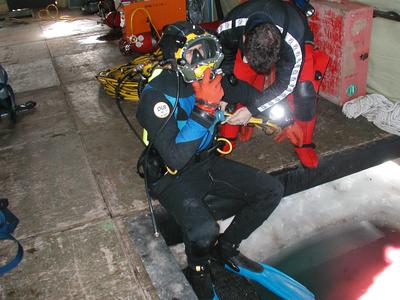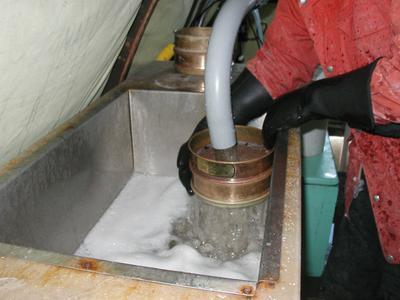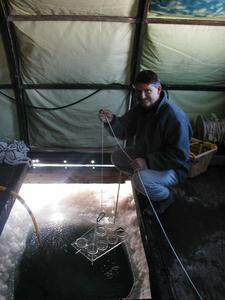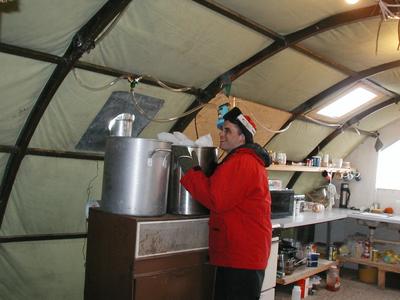
|
|
23 November, 2001
Today was Thanksgiving at home, so I tried for hours to call home, but
could not make a connection until later that night. With thoughts of loved
ones back home, life went on in camp. A little Adelie penguin walked by as
I was setting up another tent to see if it would be a better choice than
the previously tested tent. It seemed to be slightly bigger and the zippers
worked a lot better. Later in the evening, Phil Forte, Dr. Bowser, and Dr.
Korsun took gear, equipment, and supplies to the Herbertson Glacier dive
site. They took a six-wheeler, which later conked out, and two Ski-Doos
pulling sleds. Equipment, gear, supplies, water, camp gear, and extra
clothes were hauled 90 minutes away from Explorers Cove. The mission was to
begin the drill/melt process, which would take about two days, to make a
dive hole for a comparison study with organisms at Explorers Cove. Dr.
Bowser had set up a schedule, so two people could oversee the melting
process at all times. Dr. Bowser arrived back at Explorers Cove around 2:00
a.m. Dr. Korsun and Phil Forte set up a camp for shelter against the wind,
if needed. A generator and a hole-melter were placed on a huge drop cloth.
Extreme care had to be taken, so oil or fuel would not get on the ice. In
Antarctica, protecting this pristine environment is a major concern and
expectation. Dr. Alexander and Dr. Pawlowski will relieve them tomorrow,
and Dr. Bowser and I are scheduled to go tomorrow "night". At this time of
the year, Antarctica has 24 hours of sunlight, so "night" many times runs
into the next day without realizing it.
During the day, before leaving for the Herbertson site, Phil Forte made a
surface air supply dive, while Dr. Korsun worked at the airlift (the top
one-centimeter of sediment at the bottom was vacuumed and airlifted to the
surface). Dr. Korsun sifted through the sediment to collect forams. The
forams must be kept in cold "sea water" and never get above 6 degrees
Celsius. Dr. Alexander tested out his "foram farm". He invented a tray,
which can be lowered down into the hole, where the forams can put out their
web of pseudopods to see how widespread their webs reach in their natural
environment. He will place this tray with eight culture dishes down through
the dive hole to the bottom of the ocean. He will leave them there for four
or five days. I spent time sorting through forams. I also tried chipping
ice from the blue ice at the transition zone. Dr. Pollock told me that blue
ice would not be as salty, so this would be the best ice to get for
washing. Sometimes, I feel that I'm in a "cold" version of "Little House on
the Prairie". Even brushing your teeth in the morning can be an ordeal. The
ice must first be chipped and melted on the preway stove. After brushing
teeth, the water collected in a bucket under the sink must be thrown in the
wastewater container when it gets too full. We must constantly be aware of
the simple things in life. Gloves, sunglasses, and sunscreen are needed
just to walk out the door. I find myself watching each step, as I walk out
on ice. These things take up time, but along with the time consuming tasks
comes the unexpected beauty and surprises. When I went to take hydrology
measurements today, I noticed that the moat area had started to melt
extensively. The air temperature today was an unbelievable 30 degrees
Fahrenheit. It felt like a calm summer day. I am getting acclimated to the
cold weather here, although the wind still cuts right through me when it
starts to blow.

Phil Forte getting ready to make a surface supply dive.at the dive hut. He is attached to an air hose from the surface.

The surface air supply hose allows the diver to breathe air provide from an oxygen tank at the surface. A communication line is also attached to this hose, which enables the diver to communicate with people at the surface. The hose is attached to Phil Forte as he descends to the bottom of the ocean.

Dr. Korsun is using the airlift to bring up sediment with foram specimens from the top one centimeter at the bottom of the ocean.

A closer look at Dr. Korsun using the airlift to bring up forams. Phil Forte made adjustments with the airlift at the bottom of the ocean to carefully bring up only the top one-centimeter of sediment.

Dr. Steve Alexander testing his "foram farm" invention.

Blue ice is chipped from the nearby transition zone to provide our field camp with wash water.

Dr. Korsun bringing in ice to be melted on the preway stove.
Contact the TEA in the field at
.
If you cannot connect through your browser, copy the
TEA's e-mail address in the "To:" line of
your favorite e-mail package.
|
